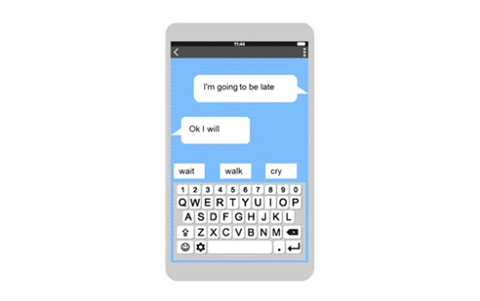Exploring predictive text

About this lesson
In this learning sequence, students analyse and apply predictive text in various contexts, including SMS messaging, email and online search engines, to enhance their understanding of language models and common language patterns.
Year band: 5-6
Curriculum Links AssessmentCurriculum Links
Technologies – Digital Technologies
Years 5-6
Collaborating and managing
Select and use appropriate digital tools effectively to create, locate and communicate content, applying common conventions AC9TDI6P07
AI-related elaboration
- judging the tone and appropriateness for the intended audience of text generated using autocomplete; for example, deciding that the predictive text was too formal for a conversation with a friend and rewriting it in more casual language
English - Literacy
Year 6
Examine texts including media texts that represent ideas and events, and identify how they reflect the context in which they were created AC9E6LY01
Learning map and outcomes
Learning intention
To understand the concept of predictive text and its relevance in everyday communication and online search.
Success criteria
Students will be able to:
- choose appropriate predictive responses for SMS messages and justify choices
- predict the next word in ‘I like to ...’ sentences based on common language patterns
- write predictions for search requests and compare them to actual predictive text suggestions
- explain the purpose of predictive text in the use of digital tools.
Preparation and materials
- Choosing a predictive response [Word]
- Predictive text language model activity [Word]
- Teaching slides
- Internet-enabled devices for research (optional)
Learning hook
Consider setting up a scenario in which you start typing an SMS message visible to the class on a large screen; pause, and let students predict the next word.
You may decide to use the Teaching slides to support this lesson.
Explain the concept of predictive text and its relevance in everyday communication and online search.
Ask: What is the purpose of predictive text?
Expect suggestions such as:
- speed and efficiency
- ease of using technology
- reduce spelling errors
- accessibility.
Learning input and construction
Provide students with the sheet Choosing a predictive response.
Review the instructions and example messages.
Allow students time to work through each SMS message, choosing an appropriate predictive response and justifying their choice.
Discuss the responses as a class, focusing on the reasons behind the choices made by students.
Responses to the first SMS example could look like this:
SMS message: Hey, are you free tonight?
Predictive responses:
- Sorry, I have other plans
- Yes, I'm free. What's up?
- I can't tonight, but I'm available tomorrow.
Student response: I would send ‘Yes, I'm free. What's up?’
Justification: This response acknowledges the question and indicates availability, inviting further conversation.
Differentiation
- Provide different levels of text complexity for the SMS messages based on students' reading levels. For example, some students may work with simpler messages, while others tackle more complex messages.
- Provide a word bank or sentence starters for students who need additional assistance in choosing predictive responses and justifying their choices.
Learning demo
Distribute the sheet, Predictive text language model activity.
The worksheet has two main parts.
- Students predict the next word in the sentence "I like to ..." for each paragraph based on common language patterns.
- Students write three predictions for search requests related to common topics such as ‘What is the largest ...’
Encourage students to explain their predictions, considering the words and activities mentioned in the paragraphs or the search prompts and how they influenced their choices.
Share and discuss the predictions as a class, highlighting the use of language patterns in making predictions.
Expect predictions similar to:
| Cooking | Video gaming | Sports |
|---|---|---|
|
I like to bake I like to cook I like to try new recipes I like to experiment in the kitchen I like to make desserts |
I like to play games I like to explore virtual worlds I like to complete quests I like to compete online I like to level up my character |
I like to play soccer I like to shoot hoops I like to stay active I like to compete in leagues I like to be part of a team |
Reflection
Lead a discussion on the activity, asking questions such as:
- How would you describe predictive text to someone who is not familiar with this concept?
- How would you describe the predictions you made?
Next steps
Use the resources in this lesson developed by CS in Schools on Generative AI to help students how Generative AI systems such as ChatGPT and DALL.E work and how they are related to the classification and predictive systems.
Why is this relevant?
A language model is a statistical model that is used in natural language processing (NLP) to predict the likelihood of a sequence of words or phrases. It is based on the analysis of large amounts of text data to understand the structure and patterns of a language. Language models are used in various applications, including machine translation, speech recognition, and predictive text.
In predictive text, a language model predicts the next word or phrase a user is likely to type based on the context of the text being entered. The model analyses patterns in the language, such as common word sequences and phrases, to make these predictions. Over time, the model can be refined and improved through additional data and learning to make more accurate predictions.
Resources
- Teacher slides: Exploring predictive text
- Video: AI in our everyday life
- Sheet: Choosing a predictive response
- Sheet: Predictive text language model activity
- Follow up lesson: Lesson 3: Generative